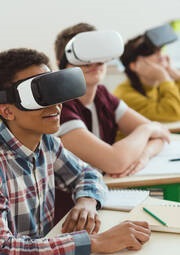How Does Virtual Reality Help In Education? And Benefits
A new avenue for teaching and learning resources is getting opened up by virtual reality (VR) in education. The foundation of virtual reality is the product of a 360-degree digital world, which offers a stimulating and immersive user experience that seems genuine.
Here, we will explore some advantages of adopting VR in school and how it may enhance education. Thus, Tech Review Advisor helps you in finding the best virtual reality for your education purpose.
What Is Virtual Reality(VR) technology?
A simulated world may be produced by computers using virtual reality (VR). Users may explore and engage with the artificially created, computer-generated world that gets created. While traditional user interfaces do not immerse the user in the experience, virtual reality does. Users may engage with the captivating 3D environment instead of merely observing it, on a screen, in front of them. Tech Review Advisor helps you in gaining more knowledge on Virtual Reality in education. The computer becomes a gatekeeper to this synthetic world by replicating as many sensations as, including vision, hearing, touch, and even smell.
Why is VR technology chosen in school education?
In education, virtual reality gets utilised to increase students’ interest in their studies. The real world we live in gets created by virtual reality. It can change how education gets delivered in the modern world. It may also employ in the military, medical field, security industry, anti-terrorism field, forecasting weather, etc.
What makes VR effective in education?
The usage of virtual reality can improve learning and engagement among students. The idea behind virtual reality (VR) education gets to create a virtual environment, whether real or made up, and let users view and engage with it. It can completely change the way that educational information gets given.
Visual learning helps you be more driven to comprehend what you are studying when you are engaged in it. Processing the information will be less mentally taxing.
Here are a few characteristics that make virtual reality in teaching so effective.
Enhances understanding
Students might have trouble understanding complex ideas that benefit from VR in the classroom.
For instance, biology students may observe brain structures and neurons from various angles using VR headsets and instructional apps. A form may get rotated to get seen from several perspectives, even from the inside.
Virtual reality (VR) may liven up the classroom and provide pupils with real-world experiences that aid in developing new understandings.
Students can better understand complex ideas when they can picture them.
VR makes it easier to demonstrate practical abilities
Although it is common knowledge that individuals learn best by doing, current schooling shows how little learning occurs by doing. Students are more concerned with reading instructions than really putting them into practice.
VR in education gives the lessons an experiential anchor. Learning with VR inspires students to make their discoveries.
Instead of just passively reading, students may learn by doing.
Virtual field trips
Through the creation of a completely immersive sense of time and location, virtual reality (VR) may be utilised to interest pupils in historical and geographical issues.
Consider taking a student to the Great Wall of China. Virtual reality in education can make it possible even when no school funding could physically support these excursions.
More educational than simply reading about history or geography is providing an immersive sense of place and time. Virtual reality panoramas get used on every excursion, which ranges from visits to historical sites to Mars. Additionally, locations that are inaccessible in person can get visited by people from all over the world.
Naturally, virtual reality will never be able to take the place of actual travel and excursion experiences. But VR makes experiences conceivable that wouldn’t otherwise be possible.
Scalable VR training
Institutions require consistent investment in training tools for their students, such as science lab equipment, medical equipment, etc.
Budgets are tight, and all this equipment needs to be maintained and upgraded.
By merely investing in the software and a reasonably priced VR box or VR headset, teachers may grow their operations at a far cheaper cost.
Students who use virtual reality can also learn valuable skills. The ability to learn from real-world situations is one of the massive advantages of this style of instruction.
Because they happen in a secure and regulated virtual world, the effects of mistakes made by pupils during VR instruction are low.
Additionally, VR enables students to experiment with topics they wouldn’t have access to in a classroom.
Conclusion:
Without a doubt, virtual reality in education will result in a beneficial change in the efficiency of information transfer.
Additionally, VR may get used in more modern technology in the classroom and assist students in creating a better future for themselves and those around them.
With the advent of VR technology, schools will get equipped with cutting-edge equipment that will improve student engagement and learning.
Over the next several years, it is anticipated that virtual reality in education will become more prevalent.
Read About More Cutting Edge Tech Being Used in Schools
Why schools should invest in 3d scanners for their students.





